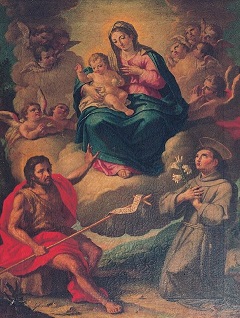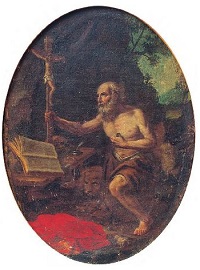The main altar of the small church of Santa Maria di Costantinopoli makes up its structural parts in limestone typical of the area. The antependio sees the presence of frames that enrich the conformation.
 On the upper part there is a pictorial canvas depicting the Madonna of Constantinople with Child this work is attributed to the painter's creativity Vincenzo Fato (Castellana Grotte 1705-1788). In the pictorial representation the Madonna is surrounded by the characteristic angels that the painter drew, and is located between Sant'Antonio da Padova and San Giovanni Battista.
On the upper part there is a pictorial canvas depicting the Madonna of Constantinople with Child this work is attributed to the painter's creativity Vincenzo Fato (Castellana Grotte 1705-1788). In the pictorial representation the Madonna is surrounded by the characteristic angels that the painter drew, and is located between Sant'Antonio da Padova and San Giovanni Battista.
Sant'Antonio is recognizable by the lily, an emblem that makes him identifiable in many iconographic representations; The lily represents its purity and the fight against evil.
 Vincent Fato vocation as a hermit, and to await the translation of the Bible from Greek into Latin
Vincent Fato vocation as a hermit, and to await the translation of the Bible from Greek into LatinSan Girolamo is without clothes and with the habit and with the galero (hat) cardinal thrown on the ground semantically to want to symbolize the renunciation of his honors. On the canvas, Fate also depicted the lion from which he had removed the thorn from his foot, the Crucifix to whom he addresses adoration and a skull as a symbol of penance while he continues to beat his chest with the stone.
